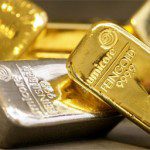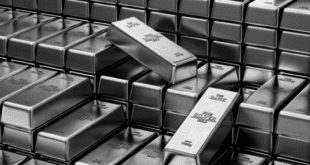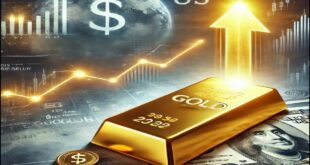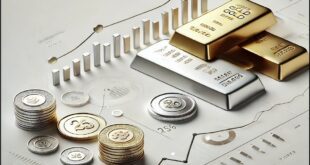Silver is selling at less than half its 2011 high. It is being ignored more than gold. It has explosive fundamentals. This article assesses silver’s potential by looking at the big-picture forces that could impact silver over the next several years – and point to a possible runaway price scenario.
has explosive fundamentals. This article assesses silver’s potential by looking at the big-picture forces that could impact silver over the next several years – and point to a possible runaway price scenario.
Clark goes on to say in further edited excerpts:
The most significant catalysts for silver are:
#1: Monetary Abuse
In a world of endless fiat money printing and unsustainable debt, silver (like gold) represents a wealth protection against systemic risk.
At no time in history has a government printed this much money and not one currency in the world is anchored to gold or any other tangible standard. This unprecedented setup means that whatever fallout results, it will be historic and affect each of us personally. Silver will be one refuge from that storm—and given its higher volatility, could rise more than gold.
#2: Inflation-Adjusted Price Has a Long Way to Go
One specific indicator of silver’s potential is its inflation-adjusted price…
Below is the silver price adjusted for both the CPI-U, as calculated by the Bureau of Labor Statistics; and for ShadowStats data based on the CPI-U formula from 1980 (the formula has since been adjusted multiple times to keep the inflation number as low as possible).

The $48 peak in April 2011 was less than half the inflation-adjusted price of January 1980, based on the current CPI-U calculation. If we use the 1980 formula to measure inflation, silver would need to top $470 to beat that peak.
I’m not counting on silver going that high (at least I hope not, because I think there would be literal blood in the streets if it did) but clearly, the odds are skewed to the upside—and there’s a lot of room to run.
#3: Tight Production Margins
Producers have been forced to reduce costs in light of last year’s crash in the silver price. Some have done a better job at this than others, but look how far margins have fallen.

Relative to the cost of production, the silver price is at its lowest level since 2005. Keep in mind that cash costs are only a portion of all-in expenses, and that the silver price has historically traded well above this figure (all-in costs are just now being widely reported). That margins have tightened so dramatically is not sustainable on a long-term basis without affecting the industry. It also makes it likely that prices have bottomed, since producers can only cut expenses so much.
Although roughly 75% of silver is produced as a byproduct, prices are determined at the margin; if a mine can’t operate profitably or a new project won’t earn a profit at current prices, output would fall.
Much of the current cost-cutting has come from reduced exploration budgets, which will curtail future supply and, sooner or later, this supply deficit will serve as a catalyst for higher prices.
#4: Low Inventories
Various entities hold inventories of silver bullion, which were high when US coinage contained silver. As all US coins intended for circulation have been minted from base metals for decades, the need for high inventories is thus lower today but this chart shows that little is available.

You can see how low current inventories are on a historical basis, most of which is held in exchange-traded products (ETPs). This is important because these investors have been net buyers since 2005 and thus have kept that metal off the market. The remaining amount of inventory is 241 million ounces, only 25% of one year’s supply—whereas in 1990 it represented roughly eight times supply. If demand were to suddenly surge, those needs could not be met by existing inventories. In fact, ETP investors would likely take more metal off the market. (The “implied unreported stocks” refers to private and other unreported depositories around the world, a number that also has shrunk strikingly.)
If investment demand were to repeat the surge it saw from 2005 to 2009, it would leave little room for error on the supply side.
#5: Conclusion of the Bear Market
The snapshot below of 6 decades of bear markets signals that ours is near exhaustion. The yellow line represents silver’s price action from April 2011 through July 11, 2014.

The historical record suggests that buying silver now is a low-risk investment.
#6: Cheap Compared to Other Commodities
Here’s how the silver price compares to other precious metals, along with the most common base metals.
|
Percent Change From…
|
||||
| 1 Year Ago |
5 Years Ago |
10 Years Ago |
All-Time High |
|
| Gold | 0% | 41% | 241% | -29% |
| Silver | 2% | 46% | 266% | -56% |
| Platinum | 6% | 23% | 87% | -34% |
| Palladium | 16% | 257% | 243% | -20% |
| Copper | -1% | 40% | 152% | -30% |
| Nickel | 30% | 25% | 16% | -64% |
| Zinc | 16% | 37% | 109% | -51% |
Only nickel is further away from its all-time high than silver.
#7: Low Mainstream Participation
Another indicator of silver’s potential is how much it represents of global financial wealth, compared to its percentage when silver hit $50 in 1980.

In spite of ongoing strong demand for physical metal, silver currently represents only 0.01% of the world’s financial wealth. This is one-twenty-fifth its 1980 level. Even that big price spike we saw in 2011 pales in comparison.
There’s an enormous amount of room for silver to become a greater part of the mainstream investment community.
#8: Watch Out For China!
It’s not just gold that is moving from West to East. Silver market trading volumes rose sharply last year, mostly a result of the Shanghai Futures Exchange (SHFE) initiating overnight trading.

- The SHFE has overtaken the Comex and become the world’s largest futures silver exchange accounting for 48.6% of all volume last year while the Comex is in sharp decline, falling from 93.4% market share as recently as 2001 to less than half that amount today.
- Domestic silver supply in China is expected to hit an all-time high and exceed 250 million ounces this year (between mine production, imports, and scrap). By comparison, it was less than 70 million ounces in 2000. However, virtually none of this is exported and is thus unavailable to the world market.
- Chinese investors are estimated to have purchased 22 million ounces of silver in 2013, the second-largest amount behind India. It was zero in 1999.
- The biggest percentage growth in silver applications comes from China. Photography, jewelry, silverware, electronics, batteries, solar panels, brazing alloys, and biocides uses are all growing at a faster clip in China than any other country in the world.
Conclusion
Based on this review of big-picture data, what conclusion would you draw? If you’re like the Hard Assets Alliance team and me, you’re forced to acknowledge that the next few years could be a very exciting time for silver investors…
Editor’s Note: The author’s views and conclusions in the above article are unaltered and no personal comments have been included to maintain the integrity of the original post. Furthermore, the views, conclusions and any recommendations offered in this article are not to be construed as an endorsement of such by the editor.
*http://www.hardassetsalliance.com/investing-news/editorial/silver-as-close-to-a-no-brainer-investment-as-it-gets (© 2014 Hard Assets Alliance, LLC; All Rights Reserved; If you haven’t looked at the services offered by the Hard Assets Alliance, go here to do so. It really is a better way to buy, store, and sell precious metals.) Original article is © 2014 Casey Research, LLC
All rights reserved.
If you liked this article then “Follow the munKNEE” & get each new post via
- Our Newsletter (sample here)
- Twitter (#munknee)
Related Articles:
1. The Case For $5,000 Silver – Yes, $5,000 Silver
If the price of silver were based directly on the real physical silver market, silver’s price should be at $5,000 an ounce. I’m not saying the price of silver will reach $5,000 an ounce; I’m just saying that the actual PHYSICAL silver spot price is not only extremely undervalued, but that it is an illusion compared to the real value of an ounce of physical silver, since it is totally disconnected from reality. [Let me explain further.] Read More »
I believe that the Silver to Gold Ratio has peaked, making silver a compelling bargain relative to gold. From today’s vantage point it is difficult believing that the price of silver could ever equal or exceed the price of gold but, when one considers the possibilities, there are many good reasons to accumulate as much silver as possible at today’s prices. Read More »
3. Silver’s Neon “Sale!” Sign Is Flashing Like A Disco Ball! Here Are 7 Reasons Why
Eventually, all markets correct excesses. The global economy is near a tipping point, and we must prepare our portfolios now, ahead of that chaos, for a big payday which means owning a meaningful amount of physical silver in addition to gold. Let me offer 7 reasons why that is the case. Words: 1588 Read More »
4. Silver Is THE “Achilles Heel” Of the Entire Financial System
In my opinion the “final financial shot’ which leads to live financial fire (collapse) will be in either the gold or silver pits of the COMEX or, ultimately, both. Why? Because, at $20 per silver ounce, it would take only $1.2 billion to crack that market open like a watermelon; because, for a pittance of money in today’s world, “trust” in the entire financial system of the West can be shattered. Some will say “big deal” or “who cares?” but it is a big deal and YOU should care! Read More »
5. 4 Unique Characteristics Should Propel Silver Skyward
With the likes of Ray Dalio and billionaire George Soros placing big bets on a recovery in precious metals now is likely the time for investors to take the plunge. The key question remains, however, which precious metal? My preference is silver. Here’s why. Read More »
6. Apply Gold:Silver Ratio Ups & Downs to Greatly Increase Your PM Holdings – Here’s How
Should you buy & hold your gold or silver or switch back and forth depending on the gold/silver ratio? This article examines 3 scenarios and identifies certain rules that should be followed to make the most of the ups and downs of the gold/silver ratio to substantially increase your holdings over time. Read More »
7. Silver Presents A “Golden” Investment Opportunity – Here’s Why
Silver has a reputation for being gold’s less desirable sister, but make no mistake, silver may still be a golden opportunity to invest in. Silver’s use is already very prevalent in the photography, consumer electronics, medical, and high tech industries and a major consumer of silver in the future will be the green technology sector in products such as solar cells and batteries. Read More »
8. Move Up In Silver To Be Sharper, Greater & Faster Than Gold – Here’s Why
Analysts and investors seem to be very bearish towards silver, but we think that the fundamentals of silver are now becoming extremely attractive in terms of contrarian opportunities. Volatility and risk are not always commensurate, and we believe that silver offers investors fundamentals that can be much stronger than expected and returns that would be magnified by the small size of the silver market (and the bearish positioning by participants). Contrarian investors would be wise to take note. Read More »
9. Silver Likely to Rally Even Farther & Faster Than Gold In Coming Months – Here’s Why
It is a reasonable bet that gold, about 40% below its 2011 high and facing large demand and dwindling supply, will rally in price over the next few years. Silver prices will follow gold prices but rally farther and faster from their currently low and oversold condition. Read More »
10. Gold:Silver Ratio Suggests Much Higher Future Price for Silver – MUCH Higher!
The majority of analysts maintain that gold will reach a parabolic peak price somewhere in excess of $5,000 per troy ounce in the next few years. Given the fact that the historical movement of silver is 90 – 95% correlated with that of gold suggests that a much higher price for silver can also be anticipated. Couple that with the fact that silver is currently greatly undervalued relative to its average long-term historical relationship with gold and it is realistic to expect that silver will eventually escalate dramatically in price. How much? This article applies the historical gold:silver ratios to come up with a range of prices based on specific price levels for gold being reached. Words: 691 Read More »
 munKNEE.com Your Key to Making Money
munKNEE.com Your Key to Making Money



Said another way Silver could very easily outshine Gold.